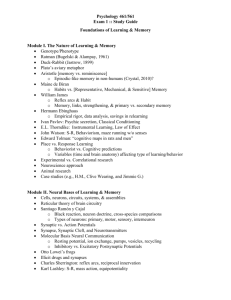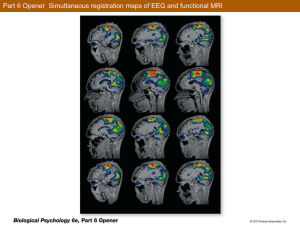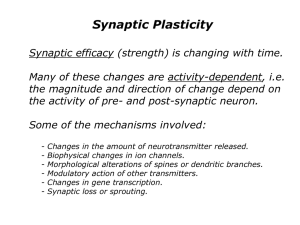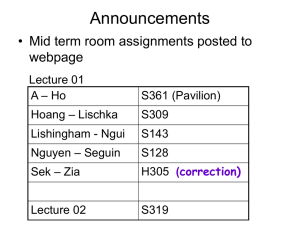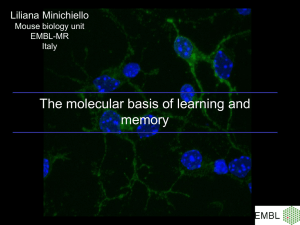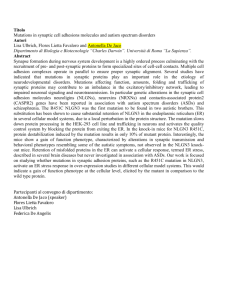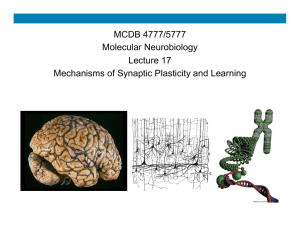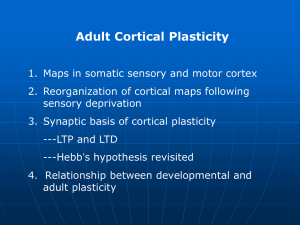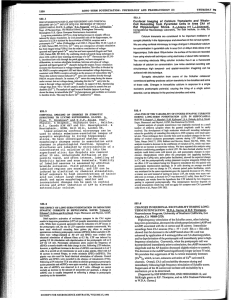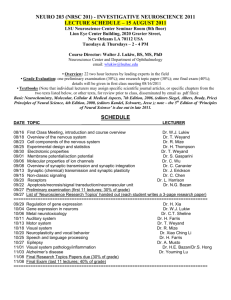1 Contact address: Laboratory of Biological Psychology, KU Leuven
advertisement
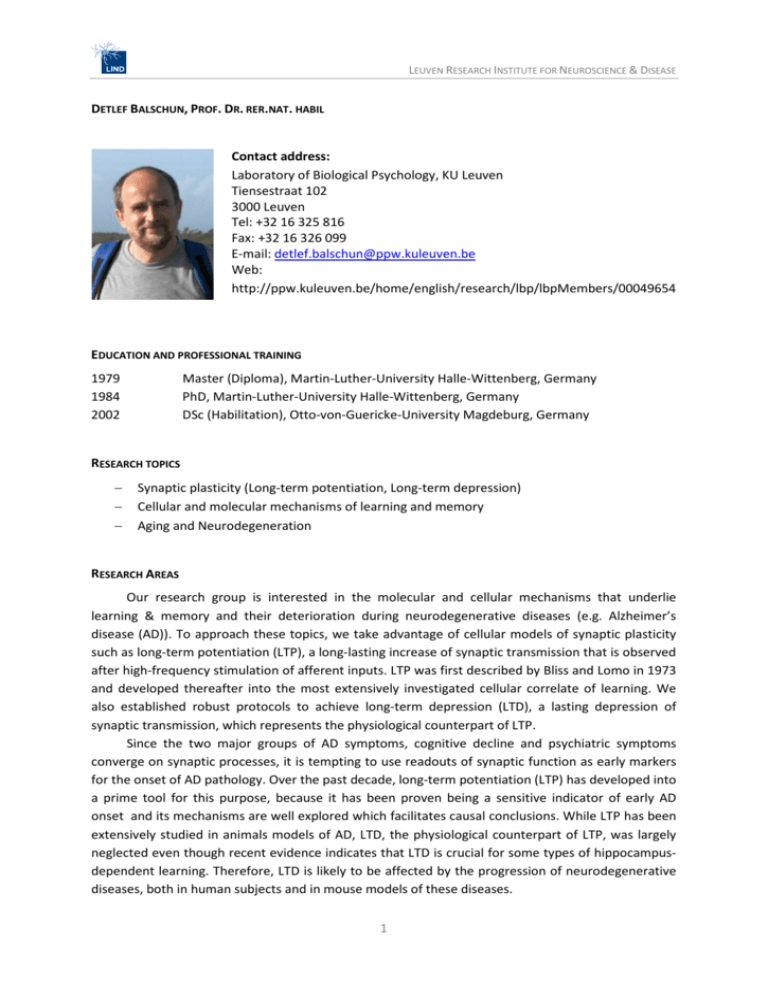
LEUVEN RESEARCH INSTITUTE FOR NEUROSCIENCE & DISEASE DETLEF BALSCHUN, PROF. DR. RER.NAT. HABIL Contact address: Laboratory of Biological Psychology, KU Leuven Tiensestraat 102 3000 Leuven Tel: +32 16 325 816 Fax: +32 16 326 099 E-mail: detlef.balschun@ppw.kuleuven.be Web: http://ppw.kuleuven.be/home/english/research/lbp/lbpMembers/00049654 EDUCATION AND PROFESSIONAL TRAINING 1979 1984 2002 Master (Diploma), Martin-Luther-University Halle-Wittenberg, Germany PhD, Martin-Luther-University Halle-Wittenberg, Germany DSc (Habilitation), Otto-von-Guericke-University Magdeburg, Germany RESEARCH TOPICS − − − Synaptic plasticity (Long-term potentiation, Long-term depression) Cellular and molecular mechanisms of learning and memory Aging and Neurodegeneration RESEARCH AREAS Our research group is interested in the molecular and cellular mechanisms that underlie learning & memory and their deterioration during neurodegenerative diseases (e.g. Alzheimer’s disease (AD)). To approach these topics, we take advantage of cellular models of synaptic plasticity such as long-term potentiation (LTP), a long-lasting increase of synaptic transmission that is observed after high-frequency stimulation of afferent inputs. LTP was first described by Bliss and Lomo in 1973 and developed thereafter into the most extensively investigated cellular correlate of learning. We also established robust protocols to achieve long-term depression (LTD), a lasting depression of synaptic transmission, which represents the physiological counterpart of LTP. Since the two major groups of AD symptoms, cognitive decline and psychiatric symptoms converge on synaptic processes, it is tempting to use readouts of synaptic function as early markers for the onset of AD pathology. Over the past decade, long-term potentiation (LTP) has developed into a prime tool for this purpose, because it has been proven being a sensitive indicator of early AD onset and its mechanisms are well explored which facilitates causal conclusions. While LTP has been extensively studied in animals models of AD, LTD, the physiological counterpart of LTP, was largely neglected even though recent evidence indicates that LTD is crucial for some types of hippocampusdependent learning. Therefore, LTD is likely to be affected by the progression of neurodegenerative diseases, both in human subjects and in mouse models of these diseases. 1 LEUVEN RESEARCH INSTITUTE FOR NEUROSCIENCE & DISEASE In addition to the hippocampus, which has a pivotal role in declarative and configural types of learning, we are interested in the prefrontal cortex (PFC), a brain region that participates in several higher order processes such as working memory, novelty detection (familiarity discrimination), decision making, associative types of memory and their extinction. Most of our work is done on brain slices (extracellular, patch-clamp and multielectrode array recordings), but we introduced recently also in-vivo recording techniques with conventional and multi-array electrodes to strengthen the links to behaviour. SELECTED PUBLICATIONS 1. Trovo L, Ahmed T, Callaerts-Vegh Z, Buzzi A, Bagni C, Chuah M, Vandendriessche T, D'Hooge R, Balschun D, Dotti CG (2013) Low hippocampal PI(4,5)P(2) contributes to reduced cognition in old mice as a result of loss of MARCKS. Nat Neurosci 16:449-55. 2. Van der Jeugd A, Ahmed T, Burnouf S, Belarbi K, Hamdame M, Grosjean ME, Humez S, Balschun D, Blum D, Buee L, D'Hooge R (2011) Hippocampal tauopathy in tau transgenic mice coincides with impaired hippocampus-dependent learning and memory, and attenuated late-phase longterm depression of synaptic transmission. Neurobiol Learn Mem 95:296-304. 3. Schmeisser,M.J., Ey,E., Wegener,S., Bockmann,J., Stempel,A.V., Kuebler,A., Janssen,A.L., Udvardi,P.T., Shiban,E., Spilker,C., Balschun,D., Skryabin,B.V., Dieck,S., Smalla,K.H., Montag,D., Leblond,C.S., Faure,P., Torquet,N., Le Sourd,A.M., Toro,R., Grabrucker,A.M., Shoichet,S.A., Schmitz,D., Kreutz,M.R., Bourgeron,T., Gundelfinger,E.D., & Boeckers,T.M. et al. (2012) Autistic-like behaviours and hyperactivity in mice lacking ProSAP1/Shank2. Nature 486:256260. 4. Van der Jeugd A, Hochgrafe K, Ahmed T, Decker JM, Sydow A, Hofmann A, Wu D, Messing L, Balschun D, D'Hooge R, Mandelkow EM (2012) Cognitive defects are reversible in inducible mice expressing pro-aggregant full-length human Tau. Acta Neuropathol 123:787-805. 5. Koch,D., Spiwoks-Becker,I., Sabanov,V., Sinning,A., Dugladze,T., Stellmacher,A., Ahuja,R., Grimm,J., Schuler,S., Muller,A., Angenstein,F., Ahmed,T., Diesler,A., Moser,M., tom,D.S., Spessert,R., Boeckers,T.M., Fassler,R., Hubner,C.A., Balschun,D., Gloveli,T., Kessels,M.M., & Qualmann,B. et al. (2011) Proper synaptic vesicle formation and neuronal network activity critically rely on syndapin I. EMBO J 30:4955-4969. 6. Balschun D, Moechars D, Callaerts-Vegh Z, Vermaercke B, Van Acker N, Andries L, D'Hooge R (2010) Vesicular glutamate transporter VGLUT1 has a role in hippocampal long-term potentiation and spatial reversal learning. Cereb Cortex 20:684-693. 7. Denayer E, Ahmed T, Brems H, Van Woerden G, Borgesius NZ, Callaerts-Vegh Z, Yoshimura A, Hartmann D, Elgersma Y, D'Hooge R, Legius E, Balschun D (2008) Spred1 is required for synaptic plasticity and hippocampus-dependent learning. J Neurosci 28:14443-14449. 8. Huang KP, Huang FL, Jager T, Li J, Reymann KG, Balschun D (2004) Neurogranin/RC3 enhances long-term potentiation and learning by promoting calcium-mediated signaling. J Neurosci 24:10660-10669. 9. Balschun D, Wolfer DP, Gass P, Mantamadiotis T, Welzl H, Schutz G, Frey JU, Lipp HP (2003) Does cAMP response element-binding protein have a pivotal role in hippocampal synaptic plasticity and hippocampus-dependent memory? J Neurosci 23:6304-6314. 2


